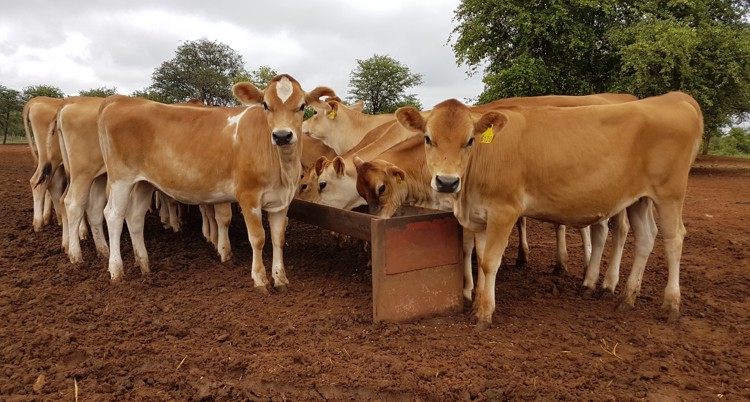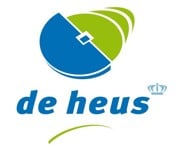Raise fewer replacement heifers
There are certain similarities between businesses and planning for the future is most certainly an integral part of them all. The biggest part of any dairy’s future is its replacement heifers and rearing heifers with which to carry the business into years to come. As with any business, when planning for the future is overlooked, a business unit is often doomed to certain failure.

De Heus recognises this vital part of any dairy business unit and has placed tremendous research, focus and time into developing a proven and economical calf rearing scheme.
De Heus has developed a well-balanced plan, based on years of experience and expertise. The De Heus Kaliber® Calf Rearing Plan is a holistic rearing plan for dairy heifers. It is designed to rear calves with Kaliber in a healthy and economical way. Kaliber refers to the animal’s proportions in terms of height, weight and size. This means that the young animal has good skeletal development without getting fat.
In order to achieve the goal of a heifer with Kaliber De Heus distinguishes four different growth phases. The STARTING PHASE from birth to 5 Months, the YOUTH PHASE from 5 to 8 Months, the PUBERTY PHASE from 8 to 14 Months and the GESTATION PHASE from 14 to 24 Months. Each phase has its own unique goals and nutritional requirements to achieve the goal of a calf with Kaliber.
The Starting Phase
The Starting Phase is meant to give the calf a solid basis for optimal future development. The goal is to achieve optimal and safe growth during the infant period by using milk or calf milk replacers together with Kaliber® Starter. One of the most divergent points is that of feeding milk before weaning. The final goal, however, is something that should never be lost. The De Heus calf growth principles are based on maximum rumen development, enabling the farmer to generate maximum growth in order to have an ideally developed heifer that can calve in 24 months at 85% of adult mass. Mass is not the only important factor as frame development as well as condition must also be taken into account.
Milk feeding plays a critical part in the early development of heifers. During the same period concentrate feed is also of critical importance as it helps with the rumen development of the heifer. Rumen papillae need propionic acid to develop and it comes mostly from concentrate sources after fermentation. Sources of roughage provide more acetic acid and thus do not really have an effect on the development of the rumen. The main focus during this period is to get a balance between milk feeding and concentrate consumption. As a rule, milk intake limits feed intake. Lower feed intake restricts rumen development and poor rumen development has a very adverse effect during the weaning period and then, of course, on later development as well. By reducing milk intake feed intake is stimulated at an earlier stage, resulting in better rumen development and therefore better adaptation to weaning as depicted in Figure 1. Although the higher growth rate looks as if it should lead to better growth rates post weaning, it is often not the case due to the post weaning dip resulting from poor rumen development.
Figure 1
After weaning, the daily growth must continue to increase. The combination of Kaliber® Starter and good quality hay insures the best development in terms of rumen volume, as well as the rumen wall.
The Youth Phase
The youth phase objective is to realize maximum growth. The growth in this phase is very efficient when the right ration is provided. It is important to stimulate maximum daily intake and supply growth specific feed. During this phase, the ration consists of good quality roughage supplemented with Kaliber® Starter and then switching to Kaliber® Junior at 6 months. With good management and nutrition, a high daily growth rate of up to 1 000 g/heifer/day can be achieved.
The Puberty Phase
The puberty phase is crucial in the rearing of heifers. The heifer’s skeleton needs to develop in length and height, without the deposition of fat. Animals with Kaliber have visible ribs and a visible backline, as well as dry udder tissue. In this phase, the percentage of compound feed in the final ration is reduced or phased out with an increase intake of top quality roughage such as grass silage or lucerne. It is an important phase in the formation of Kaliber Heifers. It is important to be sure of the guidelines for 1st insemination i.e. 166 cm chest circumference and a 133 cm height is what is required based on the Kaliber Measurement Chart. It is important to measure these aspects to ensure that your rearing plan is on the right track.
The Gestation Phase
In the gestation phase heifers are ready for insemination and gestation. This group is often neglected, yet it is very important as it is the phase where Heifers are inseminated and is a pregnant animal for a large portion of the phase. The development objective is continued growth with minimal fat deposition. A well-developed heifer enables the calf to grow properly inside her and to come into the world as a healthy animal. Kaliber heifers calve easily, are active and are able to consume higher amounts of roughage. Animals in this phase have a lower average daily gain and higher roughage intake.
What is the added benefit of the use of the Kaliber concept in your calf rearing programme?
- Quicker return on investment
- Quicker genetic growth
- Reduced fixed cost on every calf
- Increased lifetime production
- Increased 1st lactation production
- Reduced need for replacement heifers
- Cheaper rearing cost.
De Heus has done extensive research on calf rearing and the results have proved conclusively that using the Kaliber® Calf Rearing Plan had significant benefits for both cow and farmer. Heifers reared with Kaliber® were compared to heifers not reared with Kaliber® over the 1st three lactations of their adult lives with specific reference to production. Heifers reared with Kaliber® on average produced 406kg more milk in their first lactation. When followed into their second lactation again these animals showed an increase in production of 367 kg more milk over ‘non-Kaliber’ cows. In their 3rd lactation cows that were raised using Kaliber® concepts still produced 251 kg more milk than their non-Kaliber counterparts. This totalled an average of 1 024 kg more milk from three lactations. When one considers the fact that ‘non-Kaliber’ system used in this trail was an above average rearing system, results could be more favourable for many farmers.
Apart from potential added benefit in production, using the Kaliber® Calf Rearing Plan can decrease rearing costs significantly due to calving at 24 months as opposed to 30 months or even longer. This has a huge cost implication as calves are carried for 6 months less. If one does a basic sum to quantify this it is a reduction of 20% in time spent feeding so 20% less feed required. In theory, one could then spend 20% more in feed cost on heifers to ensure that they calf at the correct weight at 24 months. Also, less heifers are needed for replacement. This is either a cost saving where heifers can be sold early or and additional income where heifers are reared and then sold.
A cost often overlooked in this specific scenario is that in systems where it takes 30 months or more to get the first calf a farmer often needs to buy in heifers or cows to maintain herd size or to grow the herd. This is a cost that needs to be added to heifer rearing cost as it is not needed on farms with proper rearing and calving at 24 months. The benefits of good and efficient calf rearing clearly far outweigh the cost.


